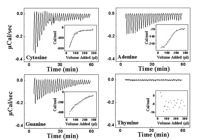1Nanoscience Group, Materials Chemistry Division and
2Organic Chemistry Division, National Chemical Laboratory, Pune – 411 008, India
e-mail: sastry@ems.ncl.res.in

| Sourabh Shukla1, A. Gourishankar2, Krishna N. Ganesh2, and Murali Sastry1
1Nanoscience Group, Materials Chemistry Division and e-mail: sastry@ems.ncl.res.in |
 |
DNA based nanotechnology has generated tremendous interest due to the programmability, reproducibility and specificity of DNA-nanoparticle interactions which essentially are the manifestations of the building blocks of DNA molecule, the nitrogenous bases. Although, diverse fields such as DNA chips, sensors, gene delivery, biodiagnostics and nanoelectronics have emerged, much remains unexplored in terms of understanding the DNA bases - nanoparticle interactions. We have, for the first time, directly measured the strengths of DNA bases/PNA monomers-gold nanoparticle interactions, in terms of the reaction exothermicities using Isothermal Titration Calorimetry (ITC), which traditionally has been used to study biological systems [1]. The significance of the study lies in the order of strength of interactions observed for the four bases and respective PNA monomers (Cytosine > Guanine > Adenine > Thymine), that differs from the previous reports which made use of indirect spectroscopic techniques as Surface enhanced Raman spectroscopy [2], Fourier transform infrared [3] and reflection absorption infrared spectroscopies [4]. We believe that these differential binding strengths, together with the remarkable specificity of base pairing and hybridization can be exploited to design sequences for developing nanoscale patterns in electronics and diagnostic applications.